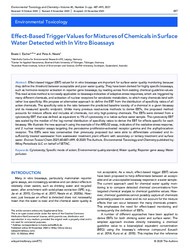Effect‐Based Trigger Values for Mixtures of Chemicals in Surface Water Detected with In Vitro Bioassays
Escher, Beate I.
Neale, Peta A.
DOI: https://doi.org/10.1002/etc.4944
Persistent URL: http://resolver.sub.uni-goettingen.de/purl?gldocs-11858/8424
Persistent URL: http://resolver.sub.uni-goettingen.de/purl?gldocs-11858/8424
Escher, Beate I.; Neale, Peta A., 2021: Effect‐Based Trigger Values for Mixtures of Chemicals in Surface Water Detected with In Vitro Bioassays. In: Environmental Toxicology and Chemistry, Band 40, 2: 487 - 499, DOI: 10.1002/etc.4944.
 |
Dokument öffnen: |
Effect‐based trigger (EBT) values for in vitro bioassays are important for surface water quality monitoring because they define the threshold between acceptable and poor water quality. They have been derived for highly specific bioassays, such as hormone‐receptor activation in reporter gene bioassays, by reading across from existing chemical guideline values. This read‐across method is not easily applicable to bioassays indicative of adaptive stress responses, which are triggered by many different chemicals, and activation of nuclear receptors for xenobiotic metabolism, to which many chemicals bind with rather low specificity. We propose an alternative approach to define the EBT from the distribution of specificity ratios of all active chemicals. The specificity ratio is the ratio between the predicted baseline toxicity of a chemical in a given bioassay and its measured specific endpoint. Unlike many previous read‐across methods to derive EBTs, the proposed method accounts for mixture effects and includes all chemicals, not only high‐potency chemicals. The EBTs were derived from a cytotoxicity EBT that was defined as equivalent to 1% of cytotoxicity in a native surface water sample. The cytotoxicity EBT was scaled by the median of the log‐normal distribution of specificity ratios to derive the EBT for effects specific for each bioassay. We illustrate the new approach using the example of the AREc32 assay, indicative of the oxidative stress response, and 2 nuclear receptor assays targeting the peroxisome proliferator–activated receptor gamma and the arylhydrocarbon receptor. The EBTs were less conservative than previously proposed but were able to differentiate untreated and insufficiently treated wastewater from wastewater treatment plant effluent with secondary or tertiary treatment and surface water. Environ Toxicol Chem 2021;40:487–499. © 2020 The Authors. Environmental Toxicology and Chemistry published by Wiley Periodicals LLC on behalf of SETAC. New effect‐based triggers were derived for bioassays that are responsive to many different chemicals with relatively low potency accounting for their mixture effects. AhR = arylhydrocarbon receptor; BEQ = bioanalytical equivalent concentration; EBT = effect‐based trigger; PPARγ = peroxisome proliferator–activated receptor gamma; SR = specificity ratio; WWTP = wastewater‐treatment plant.
Statistik:
ZugriffsstatistikSammlung:
Schlagworte:
CytotoxicitySpecific mode of action
Environmental quality standard
Water quality
Reporter gene assay
Water pollution
This is an open access article under the terms of the Creative Commons Attribution‐NonCommercial License, which permits use, distribution and reproduction in any medium, provided the original work is properly cited and is not used for commercial purposes.

